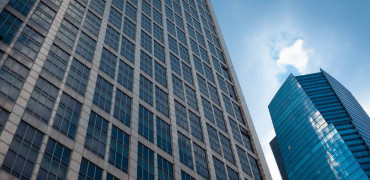If you are involved in the built environment in any way, whether as designer, installer, building owner, or facilties management team, sustainability is a topic you can no longer ignore.
If you’re approach to sustainability so far has been to ‘kick the can down the road’, then you are in real danger of being left behind, and you have missed an opportunity to help set the agenda.
The most forward-thinking companies have already seen that the sustainability agenda is actually a real opportunity, not just for growth, but for long-term, sustainable growth.
In business terms, 2050 and net zero make a strong economic case, as well as absolute environmental sense.
This got me thinking, why 2050? And actually, is that soon enough?
A price we can’t afford
At first glance getting to net zero by 2050 seems a pretty simple idea that nobody in their right mind would object to.
We need to stop and reverse the damage being done to our planet so that future generations have a planet to live on. But it can be hard to look at the bigger picture, especially in the middle of an energy and cost-of-living crisis.
Of course the soaring price of energy has focused attention on usage as never before but we need to look beyond the short term use of energy and focus on building a net zero framework for society that also takes into account embodied carbon and the whole lifecycle of a building, along with everything involved in its occupation and operational use.
Is 2050 enough of a target?
As society we need to put in place measures which reduce our carbon footprint. That means individually, together as communities, worldwide businesses and countries working collectively across the globe.
In 2019 the UK became the first major economy in the world to pass laws to end its contribution to global warming by 2050, as our prvious strategy to net zero had been deemed unlawful.
The target will require the UK to bring all greenhouse gas emissions to net zero by 2050, compared with the previous target of at least 80% reduction from 1990 levels.
This got me thinking, why 2050? And actually, is that soon enough?
Well, the reason for 2050 is simple, if we don’t drastically change our rate of carbon emissions by 2050, we will stand next to no chance in minimising the temperature rises needed to stop a global disaster.
This means we are likely to see an increase in global seal levels, causing wider flooding, a growth in deserts across the globe and more extreme temperatures, leading to more forest fires and desolation. Whole cities will become vulnerable to rising sea levels and many island nations may succumb to the sea.
As we approach the global discussion forum COP27, news emerges that our window for avoiding catastrophe is closing fast as this Guardian report states.
So unless we act soon and act together in a more co-ordinated way, the consequences are likely to mean even more drastic action is required if we are to avoid the dramatic effects of the climate crisis.
Don’t let your building get stranded
Buildings represent one of the biggest challenge, and the greatest opportunity for change. I say challenge because it is worth remembering that around 80% of current buildings have already been built and will still be here in 2050.
We are constructing lots of new buildings – and these must now be designed with sustainability in mind from the start, including advanced, modern, energy efficient systems to make them confortable places to live, work and play.
What will be equally important is how their energy performance and carbon footprint is measured throughout their entire lifecycle.
But we also face the challenge of upgrading the existing 80% of buildings as we can’t simply knock them all down and start again.
Letting agencies such as Savilles are currently reporting a 12% increase in rental prices for buildings that can clearly demonstrate their sustainability. They also state that for every such building there are at least five clients on a waiting list.
Anyone with an existing building therefore needs to plan a sustainable future now for that building or it will rapidly become a stranded asset that cannot be let. Selling these ‘dinosaurs’ will also become harder and harder – without taking a hit on price.
The solutions are already here
Thankfully, there are options open to building designers and operators in the form of low-carbon building technologies and modern methods of construction and improvement. For new-build, we will also see more modular, factory-built components, which will increase the speed and quality of buildings.
There is also technology available already that will make a difference right now.
Replacing gas and oil with a heat pump for heating is now a viable option for almost any building and, whilst the government is talking of 600,000 heat pumps being installed in homes each year by 2028, it’s worth reminding ourselves of a quicker way of reducing carbon emissions with renewable heating – commercial properties.
Whilst the adoption of heat pumps in homes is speeding up, replacing gas or oil in commercial properties is one quick way of reducing carbon, lowering running costs and future-proofing the business.
Modern commercial heat pumps are available for almost any size of building and just about any water temperature you could want.
We recently produced a whitepaper called ‘Stranded assets: A roadmap to net zero for new and existing buildings’ which can be freely downloaded here.
Come and talk to us
As one of the world’s leading manufacturer’s of heating, ventilation and air conditioning, Mitsubishi Electric has spent over a Century delivering products with quality built in from the start.
In fact our founding father set out a mission for the company which is encaptured in the phrase “We manufacture electric products of the highest quality that contribute to society.”
We have also set up a Net Zero Design Team with dedicated experts who can help and if this article has peaked your interest, please visit our webpage for more information and do please get in touch.
Dan Smith, National Construction Manager, Net Zero Design Team




